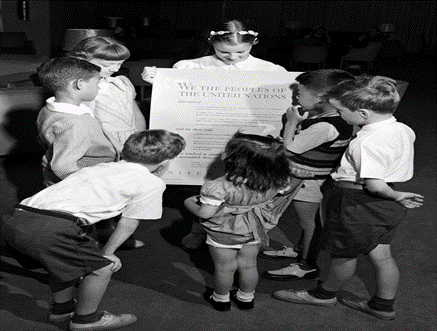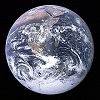10: A World of New Nations- 1945-1970
- Page ID
- 147165
-
Explain the creation and development of the United Nations
-
Explore how emergence of new nation-states across Asia, the Middle East, and Africa during the mid-20th century i.e. decolonization transformed the world
- In the United Nations, what is the role of the General Assembly?
- After 1945, why was Europe no longer the center of world affairs?
- Brazil was considered as a candidate for the UN Security Council; for what reasons might have Brazil not been chosen?
Introduction
In early 1945 fifty nations met hoping to build a “world dedicated to the dignity of man and the fulfillment of his most cherished wish for freedom, tolerance, and justice.” Together these nations created the charter of a new international organization – the United Nations. Composed of two main bodies, the United Nations or UN has a General Assembly where all member nations hold equal representation ‘one state, one vote’ to create international law alongside a Security Council led by five world powers who enforce the law. Any action by the Security Council must be unanimous with the five permanent members – the United States, China, Russia (in 1945 the Soviet Union), France, and Britain – all in agreement. Its creators sought to build a lasting international order by balancing equal representation with great power status; a blend of idealism with post World War II realism. Such realists reasoned it the primary responsibility of great powers to protect weaker nations against aggression and for idealists the United Nations became a guiding light to a new global order of independent nation-states and guardian of human rights. Figure 10.1 is a 1947 photo of the children of some UN Secretariat members looking at the Preamble of the UN Charter. One child is holding the UN Charter Preamble and six other children are gathered around her to look at the document she is displaying to them. The UN charter Preamble begins with the words, "We the Peoples of the United Nations."

- 10.1: The United Nations
- With the rise of the United Nations, the world becomes filled with new nation-states. Led by the Secretary-General, the United Nations promotes self-governance and independence across Asia, the Middle East, and Africa.
- 10.2: The New Nations of Asia
- Across Asia, independence allows some new nations like the Philippines to peacefully enter onto the world stage. For others, notably India and Pakistan, independence means division and the challenges of democratic rule.
- 10.3: The New Nations of the Middle East
- In the Middle East, Arab states gain full independence and Gamal Nasser becomes ruler of the Republic of Egypt. Israel is formed and conflict displaces the Palestinians.
- 10.4: International Crisis
- The Suez Crisis tests the United Nations world order and shows the age of European imperialism is over. In the Middle East, the beliefs in Pan-Arabism and Islamic Solidarity jostle to determine the future of the Arab world.
- 10.5: War and Peace
- In 1967 war breaks out between Israel and its neighboring Arab states.The sudden Israeli victory secures Israel's existence and shocks the Arab world as the search for peaceful co-existence begins.
- 10.6: The New Nations of Africa
- The winds of change blow across Africa as independence arrives. Idealist African leaders and optimistic peoples celebrate yet soon struggle to build new nations while European states seek to keep their influence over the continent.
- 10.7: Chapter Summary and Key Terms
- The mid-20th century saw the end of empires and emergence of a world of nations or an international world order. Across the planet new nations sought to build independent states and faced questions of governance, crisis, and belief.


